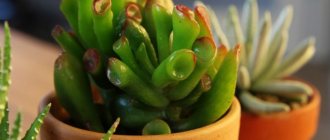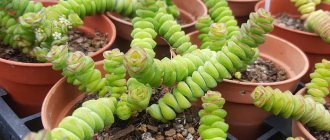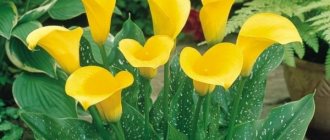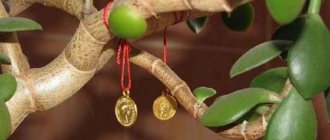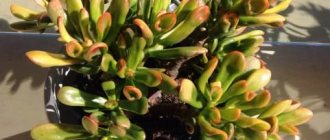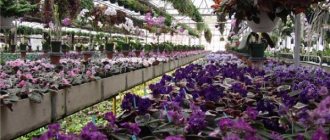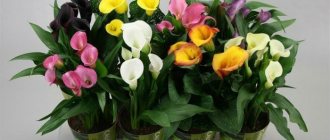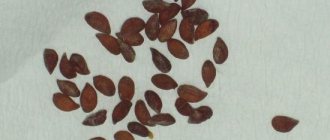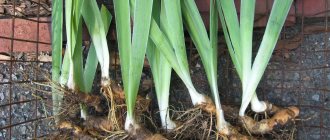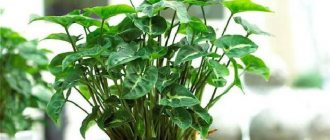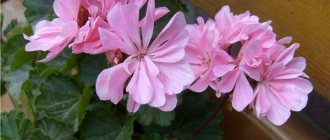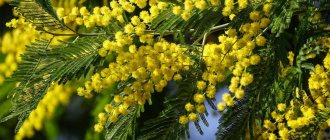Reproduction
Reference.
Crassula ovata Gollum (Hobbit) propagates in many ways: cuttings, leaves, shoots with aerial roots, dividing the bush. Everything is going well. An accidentally broken leaf, cuttings left after pruning to form the desired crown shape - use them to propagate the plant. However, it must be said that the simplest and most popular method is still cuttings. Seeds are too long and difficult, rooting leaves also has its own specifics, but a cutting about ten centimeters long is what you need.
Lightly wither the cuttings in the shade, then place them in a glass of water (you should add charcoal to avoid rotting). When the roots appear, you can plant the plant in a small container with suitable soil. A small fat plant must receive enough light, and the soil must be moistened daily, unlike adult specimens.
What similar plants are there?
- Crassula lactea. Crassula milky. One of the ancestors of the hybrid variety Crassula ovata “Gollum (Hobbit)”. This species has only a hint of fusion of leaves a la “Gollum” - they grow together at the base. The plant is small (up to 60 cm in height maximum). Delicate wide rounded leaves, white flowers - a very nice specimen for a succulent grower’s collection!
- Crassula portulacea. Crassula purslane. Also a popular succulent with elongated, obovate leaves on thick stems. Decorative and practically obligatory in the collection of home succulents of the Crassulaceae genus.
- Adromischus halesowensis. Adromiscus halesowensis. If you like the exotic, somewhat “alien” look of “Gollums” (“hobbits”) and want something similar for your collection, then you will like Adromiscus. Elongated, voluminous, glossy leaves stretching in different directions give this bush a unique, special charm.
- Peperomia graveolens. Peperomia graveolens. A cool plant with thick, oblong leaves folded into “boats.” The shape is not everything: the leaves are green on top and red below. The decorativeness is off the charts!
- Hatiora salicornioides. Hathiora saltwort. Epiphyte cactus. Its branchy green shoots resemble horns and look like cute “hobbit” leaves. If you liked the “Gollum” variety of Crassula and want something else in the same spirit for your collection, Hatiora will definitely suit you.
Sources:
- https://pocvetam.ru/komnatnye-rasteniya/sukkulenty/krassula-khobbit.html
- https://greensotka.ru/sukkulenty/krassula-khobbit.html
- https://floristics.info/ru/stati/2258-krassula-v-domashnikh-usloviyakh.html
- https://pro100ogorod.ru/tsvety/krassula-hobbit-uhod-v-domashnih-usloviyah-foto-razmnozhenie.html
- https://www.flowerbank.ru/?p=2372
- https://doma-v-sadu.ru/komnatnye-rasteniya/tolstyanka/hobbit.html
- https://kaktus-sukkulent.ru/sukkulenti/vidi-sukkulentov/krassula-khobbit-i-gollum/
- https://dacha.expert/domashnie-rasteniya/sukkulenty/krassula/raznovidnosti-kr/tolstyanka-ovata-gollum-hobbit.html
Description and features
The homeland of Crassula Ovata is South Africa, which already has more than 350 varietal species. Species diversity depends on the places in which Crassula grows. In drier conditions, unusual leaf colors and shapes stand out. Among all this diversity, there are both dwarf subtypes and powerful trees that stretch their trunk high into the sky.
The only thing that remains unchanged in a large natural assortment is the opposite leaf arrangement, the thickness of the leaves and the absence of cuts in the leaf plates. You should know that the leaves of Crassula Ovata are unsuitable for food because they contain a large amount of arsenic, which negatively affects the health of people and their pets.
Blooming Crasulla Ovata
Surprisingly, the number of pistils corresponds to the number of stamens. The flowers are quite small and collected in small bunches. Most species fit into three conditional groups:
- Tree-like - reaches a height of up to one meter. It stands out for its color on the underside of the leaves. It is characteristically red. Over time, the trunk curls and acquires a characteristic brown tint. The species actively blooms in autumn-winter. The flowers are white.
- Creeping - distinguished by their speed of covering the grass area. Its shape is very different from its predecessor, from the elongated club mosses to the thin yellow leaves of Crassula Otpryskova. It is grown mainly in summer cottages to reduce air humidity.
- Spike-shaped - have a straight stem that can reach only half a meter. The shape of the leaves is very amazing, they seem to be strung on top of each other. In terms of color, it can be either a green plant or with brown spots.
In addition to the main subspecies, there is a wide variety of different varieties that are unique in nature. It is worth considering more significant species that can be observed in the homes of most indoor plant lovers.
Medicinal properties
The familiar fat plant from the windowsill, in addition to its attractive appearance, also has medicinal properties. It purifies the air in the room, saturates it with phytoncides, which stop the growth of microbes. With the help of its leaves, small wounds, scratches, cuts and even burns are treated.
However, the leaves and juice of the money tree must be used internally with great caution, since the leaves of the money tree contain poisonous arsenic in large quantities.
- To treat wounds and cuts, make a paste from several Crassula leaves, which you apply to damaged skin. Secure the medicine with a clean bandage for several hours;
- With the help of Crassula, you can cure a cold on the lips - apply a swab soaked in the juice of the leaves of this home plant to the damaged skin of the lips several times a day;
- The money tree also works well with calluses and minor burns - to do this, cut a leaf and apply it to the wound. You can secure the sheet with a bandage or plaster;
- Crassula leaves will help relieve itching from insect bites. Lubricate the bite with a broken Crassula leaf.
- Sore throat and sore throat can also be cured by the money tree. Add the juice of 10-15 leaves to a glass of warm water. Gargle with this solution twice a day;
- Joint pain can be relieved by a compress of crushed Crassula leaves;
- To treat varicose veins, compresses with an infusion of leaves and branches of the money tree are used. The infusion is prepared over a month by pouring vodka over the leaves and finely chopped twigs of the plant in a half-liter jar;
- Stomach and duodenal ulcers can be cured if you eat two Crassula leaves half an hour before meals;
- An infusion of money tree leaves will help cure kidney inflammation. To do this, pour 5-6 leaves with a glass of boiling water and leave for an hour. The infusion is taken three times a day, a tablespoon before meals.
Diseases and pests of Crassula coral
The most serious problem in growing Crassula coral is overwatering. The root system of a plant, under conditions of oversaturation with moisture, very soon rots, the flower droops, the foliage softens and over time becomes covered with brown spots, which indicate that most of the roots have already been irretrievably lost.
The plant must be immediately removed from the pot, the roots inspected, and rotten and damaged roots removed. If there are at least a small amount of healthy roots left, it makes sense to try to save the flower. To do this, you should treat it with a solution of a fungicide, for example, foundationazole, and leave it to dry for a couple of days, then plant it in a new substrate and leave it for up to 5-6 days without watering.
The absence of new spots on the leaves indicates that the disease is receding. However, there is no need to rush to restore watering; it is advisable not to wet the plant for 2-3 weeks, only then water it very sparingly and again take a long break between waterings. Only after finally making sure that the disease has completely subsided, do they resume the watering regime with complete drying of the soil mixture between successive moistenings.
Crassula cannot be saved if, after removal from the ground, completely rotten roots are discovered. All that remains is to try cuttings into new specimens, and then only on the condition that you can choose healthy cuttings without brown spots on the foliage.
Crassula coral is resistant to most pests. In indoor conditions, it may find itself in the zone of parasitic action of aphids and mealybugs. If the pest colony is small, remove it manually using a cotton swab soaked in alcohol, or wash it off with a solution of laundry soap. If there are a lot of insects, chemical treatment with an insecticide is used, and the solution is also spilled on the soil, because among the scale insects there are species that also live in the soil.
Sometimes in stores you can buy small succulent plants under the general name “succulent mix”. An entire collection of small (and very inexpensive) succulents are displayed on one tray-pallet: take what you want. But when you bring a new pet home, you want to know the name more precisely.
For example, here are the following sentences:
If the plant name says “mix,” as in this case, it means that the houseplant can come in different colors (and types).
Succulent mix. Choose yours!
Our latest acquisitions are a couple of such plants, the names of which were established thanks to the help of people knowledgeable about succulents.
“Mixed succulents”, the names of which are yet to be determined.
Sometimes determining the exact name can cause some difficulties, because many species are quite similar. It’s easier to see the difference in an adult plant, but when you have a baby, you may have doubts.
For example, difficulties may arise when determining the type of Crassula.
For example, is this plant Crassula gollum, hobbit or coral? Apparently (see species comparison below) this is a gollum.
Crassula (crassula) gollum (C. gollum).
Crassula ovata Hobbit and Crassula gollum (C. Gollum) are similar, but the hobbit has wider leaves and more ears, and the gollum has more tubes and sticks.
Hobbit or Gollum?
Crassula hobbit (C. Hobbit) and gollum (C. Gollum) are two similar hybrid varieties created in the 1970s in the USA, presumably by crossing Crassula Ovata and Molochnaya (C. Lactea).
Both species have the original shape of the leaves, in Hobbit they are turned outward and fused from the base to the middle, and in Gollum they are completely rolled into a tube with funnel-shaped expanding tips (the so-called “Shrek ears”).
There is also Crassula Coral (C. Coral, synonymous with C. Skinny Fingers), similar to them. Most of its leaves are stick-like, tapering towards the end, with funnel-shaped tips, as well as a powerful trunk and numerous side shoots.
Crassula mix, different plants.
What is this second plant (from the first photo in the article)?
This is Cooper's Adromiscus.
Adromischus belongs to the Crassulaceae family. Native to South West and South Africa. Very thick leaves, reminiscent of “barrels”, with a wavy edge with spots.
Cooper's Adromischus.
There is a similar species called cotyledon.
And this made the mix younger.
Facts about this Crassula Ovata Hobbit
These flowers belong to the Crassulaceae family, and their homeland is South Africa . If we talk specifically about the Hobbit variety, it was discovered in the 1970s and grows in its natural habitat on rocky slopes.
The succulent has a shrub-like form and erect foliage. The trunk is branched, so it can be easily shaped into a bonsai . The edges of the leaves have a red tint, especially if the plant is grown in bright light.
New growth is also red. The pinkish-white flowers appear in clusters and look like stars. Flowering time usually occurs in late autumn or winter, but you need to understand that the tree blooms only in ideal conditions .
The common Crassula is often called the "Money Tree", but this variety has its own names, such as Jade Fingers or Hobbit Tree. But despite this, the tree is also considered lucky and, according to the practice of Feng Shui , attracts positive energy into the house.
Landing
When planting Crassula "Hobbit", special attention should be paid to preparing the substrate and choosing a pot. You can pick up the soil mixture in the store
It is better to stay with a composition intended for cacti and succulents. However, you can make the substrate yourself from available components. You need to take:
- 1 part sheet soil;
- 1 part river sand;
- 1 part turf.
All components can be assembled in an environmentally safe place away from major roads and highways. It is also necessary to add a little crushed coal, zeolite and fine expanded clay to the prepared mixture. All components must first be calcined on a baking sheet in the oven - this will destroy the larvae of insect pests, as well as pathogens of fungal, viral and bacterial infections.
You should definitely put drainage at the bottom of the container; it should occupy at least a third of the pot. Usually pebbles or expanded clay are used
This is very important, since stagnation of water leads to waterlogging of the soil, and this has the most detrimental effect on the condition of the root system and leads to the shedding of leaves
The root system of Crassula is superficial, so it is better to choose a low, but wide and flat pot for the plant. It is in such a container that the fat woman will be as comfortable as possible. The diameter of the pot should approximately correspond to the size of the crown. If it is smaller, the roots will be cramped. If you take a larger pot, the Crassula will grow and develop very slowly.
The container can be made of any material, but since the flower looks very impressive and resembles a bonsai, it will look best in a ceramic or clay container. If you wish, you can even choose a special bonsai
There is also one important requirement for Crassula pots - they must have several drainage holes to remove excess moisture from the substrate
Bloom
The most reliable way to determine the Crassula variety is to look at the flowering.
- Crassula Gollum blooms with white and pink flowers. Blooms in winter, flowering duration is average. The flowers are star-shaped, the buds are loose.
- Crassula the Hobbit has pure white flowers with very neat stars. The buds are dense and add some decorativeness. Flowering also occurs in winter. In summer, the plant mainly grows green mass.
To see flowering, when forming the crown, several shoots must be left untouched so that flower buds form on them.
Reproduction methods
Crassula reproduces well in several ways. Each gardener can choose the most convenient one for himself.
Leaf
A new plant can be obtained from one leaf
Like any succulent, Crassula easily produces new shoots from a single leaf. The seed material is cut off and set aside to dry. It is better to put it on paper in a dark, warm place.
When the cut site dries, each leaf is placed in a special sand-turf substrate. It is possible to pre-dip them in the Kornevin solution. The top of the sheet is covered with a jar or whip. In a greenhouse it will be easier for it to take root and start growing.
Cuttings
This method is the most common. Several side branches are cut off from an adult plant, washed under running water and set aside to dry. It is better to take small branches with 5-6 leaves.
When the juice stops secreting, the cuttings are placed in water, dropping a little of the Kornevin preparation into it. After the roots appear, the cuttings are placed in the prepared substrate.
Some gardeners prefer to plant shoots in the ground immediately, without placing them in water. In this case, it is necessary to have a greenhouse and a more drained soil mixture, because it will be more difficult for roots to form in the ground. However, shoots rooted in the soil grow faster than after a container of water.
Aerial roots
Sometimes an adult Crassula forms roots directly on growing shoots. If this happens, you can easily separate the segment with the roots and immediately plant it in the ground. Such shoots take root the fastest and do not require special care. True, the plant does not always take down such aerial roots.
If the branches on an adult Crassula tree are all rooted, this is not a good sign. The plant lets you know that it is uncomfortable, cramped, and lacks moisture or microelements in the soil. Most often, replanting into a larger pot with nutritious soil helps solve this problem.
Seeds
The Hobbit variety is a hybrid, so collecting seeds from it and using it for subsequent planting is not practical. Even if you manage to get seedlings, it is not a fact that this particular succulent will grow.
The shoots may not retain the properties of the mother plant. In addition, Crassula seeds do not ripen properly at home. To do this, special conditions will have to be created.
Money tree care
How to care for crassula, what features need to be taken into account when watering, choosing a place and soil for the plant?
Watering Crassula
Different types of Crassula differ little in terms of care. This is an unpretentious and hardy plant. But we must remember that the flower came to us from South Africa, and in nature it grows in desert and semi-desert areas, which means it does not tolerate the bay.
Excessive watering for Crassula is much more dangerous than lack of moisture, and easily leads to rotting of the roots and base of the stem, and fungal plant diseases such as gray rot.
If necessary, severely damaged above-ground parts of the plant should also be removed.
The intensity of watering Crassula depends on the season. In spring and summer, it is worth watering it when the top layer of soil in the pot dries out, not often, but abundantly. If the soil is dry at a depth of about two phalanges of fingers, you need to water the flower.
In autumn, the intervals between waterings gradually become longer, and in winter, during the dormant period, the soil should be moistened approximately once a month. Do not allow water to stagnate in a pot or tray and water the fat plant with cold water.
For more information on how often to water a money tree, read our article.
Landing
You can use a ready-made special mixture for succulents (if you don’t have one, a mixture intended for cacti will do) or you can make it yourself.
For this you will need:
Mix all ingredients in a ratio of 1:1:3.
Under no circumstances should the substrate be acidic; Crassula prefers neutral and alkaline soils. Therefore, a small amount of ash should be added.
For greater looseness, you can also add expanded clay or brick chips to it.
Transfer
The root system of Crassula lies near the surface, so it does not need a deep pot; its width and stability are much more important.
The plant will survive in a very small container, but due to the heavy, fleshy crown, sooner or later it will begin to tip the pot and fall on its side, and the fragile succulent shoots may break.
At the same time, you cannot select a pot “for growth”; in a large container it will pull the stems unsightly. A young plant that is actively growing its crown should change the container once a year, an adult - once every three years.
Crassula does not tolerate transplants well and often loses some of its leaves after them; it is best to transfer it without disturbing the root system.
Varieties of Ficus Benjamin: Natasha and Kinky - a description of the species, care recommendations and much more, read here.
Lighting requirements
Like any desert plant, the Crassula loves light, a sea of light!
An eastern or southern window is an ideal place to place Crassula ovata and plants of related species on the windowsill. Under the sun's rays, the edges of the leaves acquire a slight reddish tint, “sunbathe”, young shoots grow thick, powerful and do not stretch.
For all its light-loving nature, the Crassula is one of the most tolerant desert inhabitants to a lack of lighting - it will survive in partial shade. But in such conditions, its stems will be thin, the coin-shaped leaves will be pale and dull, so you should not place it in a shady place if you want to fully enjoy the beauty of the flower.
Crassula is undemanding to air humidity and does not need spraying, which many indoor plants love; it is better to simply wipe its leaves with a damp cloth so that dust does not collect on them.
Temperature
In order for the fat woman to feel good, you need to take care of the temperature in the room. During the period of active growth, it should not fall below 20 degrees, and in autumn and winter, during the dormant period, the plant should sleep at a temperature of 8 - 14 degrees. If there is a heating radiator right under the window where the flower pot is located, you can fence it off with plastic film or foil so that hot air does not rise up to the window and the crassula does not get too hot.
Features of caring for Crassula "Hobbit"
In terms of care, this unusual plant differs little from other crassulas - drought-resistant, light-loving and unpretentious.
The only thing to remember is that, unlike its wild ancestor, it does not like excess sun. Delicate coral-shaped leaves-tubes burn easily and, if the light is too bright, they can begin to turn black and die.
To avoid burns, the fat plant of this variety should be kept in a place that is sufficiently lit, but not exposed to direct sunlight.
Transfer
Young Crassula can be replanted once a year, each time slightly increasing the capacity. An adult plant is replanted approximately every three years or less.
Do not damage the delicate root system. The fat plant needs to be removed from the pot along with a lump of earth on the roots and in this form moved to a new container. If it is difficult to remove, tap on the bottom and walls of the pot. Do not get carried away with volume when transplanting crassulas: they do not need very large and deep containers. It is better to take a relatively shallow pot with a diameter slightly larger than the plant itself.
Necessary conditions for cultivation
The plant is usually without pruning and takes on its original, “bonsai” shape. The growth rate is average.
The unpretentiousness of fat women, including the Hobbit, is widely known. However, in order for the plant to delight with its healthy appearance and lush greenery, some simple care rules must be followed.
Location and lighting
All Crassulas love sunlight, and therefore the best place for them is on the windowsills of the south and southwest sides of the house. However, the succulent is ready to share a well-lit place with other, more light-sensitive plants, and develop well if it gets at least a couple of hours of sunlight a day. When constantly in the shade, it loses its decorative effect: turgor decreases, the color of the leaves fades, they fall off, and the branches become elongated. When the “correct” location of Crassula is returned, the Hobbit will gradually recover, but the process is slow.
Air humidity
This factor does not play a big role for the plant. Crassula Hobbit tolerates both summer heat and dry indoor air in winter. She suffers only from the dust that accumulates on the leaves. They need to be wiped periodically with a damp cloth or sponge.
In summer, the flower will be happy to be sprayed with water at room temperature. After this, the pot with Crassula should be shaken lightly so that the water droplets do not stagnate in the axils of the leaves, and the wet plant should not be placed in the sun so that the water droplets do not serve as lenses for the sun’s rays and cause burns.
Soil and pot requirements
Crassula Hobbit needs loose, well-drained soil, but not too nutritious. You can prepare your own soil mixture from equal parts of leaf and turf soil, coarse-grained, pre-roasted or steamed sand, a small amount of crushed brick for additional drainage and crushed charcoal as a preventative against rotting of the root system.
The best option is to purchase a soil mixture for cacti and succulents in a specialized store.
The material does not play a special role, but since the flower is distinguished by its exquisite decorativeness, they try to choose beautiful ceramic or clay pots and bonsai pots for it (moreover, the container for an adult tree should be wide and heavy enough to hold the overgrown crown).
A mandatory requirement for a Hobbit Crassula pot is the presence of drainage holes (as well as good drainage as a bottom layer).
Crassula ovate Gollum
This variety is very similar to Crassula ovata Hobbit, differing in the shape of the leaves, which only have cup-shaped extensions at the tips. It grows more slowly than its “brother” the Hobbit. It also independently forms the shape of the original type of crown. Grows on windows facing any side of the world.
The height of an adult bush reaches half a meter in height. Of all the types of Crassula, these two types - Hobbit and Gollum - are the most loved by interior designers, as they have original greenery and are not demanding of care. It is quite possible to create all the necessary conditions even in the office.
Reproduction methods
There are several ways to propagate a money tree - from cuttings, leaves and seeds.
Cuttings
The cuttings are harvested in the spring. Take an adult and healthy plant, carefully separate the lateral shoots with several leaves from the stem. Place in a container with warm water.
Stems with roots are planted in a nutrient substrate.
Leaf
Roots may form on the leaves
Some leaves may produce thin roots. You can also get new plants from them. Carefully separate it from the stem along with the root, then plant it in a light and loose mixture of compost soil and sand (1:1). Moisten and cover with film.
Keep in greenhouse conditions until new leaves appear.
The seedlings are periodically moistened and ventilated. When they get stronger and grow 2-3 pairs of leaves, they are planted in clay pots.
Seeds
Seeds collected from an adult plant are sown in bowls or seedling boxes filled with a nutritious and light mixture of leaf soil and coarse sand (1: 0.5). Spray with warm water from a spray bottle, then cover with transparent film or glass.
The glass is removed after about 2 weeks, when sprouts appear. As soon as they grow and get stronger, they are dumped into separate containers - you can use disposable small cups with holes in the bottom.
For picking, take a mixture of turf, leaf soil and sand. Grow at home in a warm and well-lit place.
As soon as one pair of leaves appears on the plants, they are planted in pots with a diameter of 5-7 cm. They are kept at a temperature of 16-17°C for 2-3 weeks, then transferred to a permanent habitat with other flowers.
Caring for Crassula at home
Temperature
. In the summer, crassulas feel great in the fresh air - they can be taken out into the garden or onto the balcony.
Lighting
. Miniature species, whose leaves are twisted into dense rosettes, love bright light and tolerate direct sunlight. But columnar and tree-like species provide shade. To ensure uniform growth of the plant, it is periodically turned in different directions towards the light.
Watering
. In summer, for compact species with dense rosettes of leaves, watering should be moderate. Columnar and tree-like ones need abundant watering, although infrequent. With the onset of autumn and lower temperatures for all types, watering is reduced to once a week. If the plant overwinters in a cool room, then water it only after the earthen ball has completely dried out; once or twice a month is enough.
Top dressing
. In summer - once every 10-14 days, alternately with mineral and organic fertilizers. For miniature species, the concentration of fertilizing should be lower than for other indoor plants. In autumn, as temperatures drop, fertilizing is applied less frequently.
Earth mixture
. For crassulas, a heavy soil mixture is used, while for groundcovers a mixture with a high sand content is used. The usual soil formula for Crassula is as follows: 4 parts of heavy turf soil and one part each of deciduous soil, humus and sand. Crassulas do not need any other additives.
Transfer
. Crassulas do not need regular transplantation. They are rarely replanted when the previous pot seems clearly too small for the plant, but frequent replanting does not harm them. When transplanting, Crassula is not buried low in the ground; usually it is left at the same depth level at which the plant was before transplantation.
The correct pot for a fat plant is shallow, but relatively wide. The diameter of the pot should be approximately equal to the estimated diameter of the plant's crown so that it stands stable.
Reproduction
. As a rule, propagation of the fat plant by cuttings and leaves is used. This is a very simple method in which plants almost always take root and grow. No special conditions are required. The fallen leaf easily takes root. You can help with this: press the bottom of the leaf to the soil and water it from time to time.
To propagate Crassula at home using stem cuttings, proceed as follows. The cuttings are cut and dried, and then planted in a sandy substrate or the soil mixture described above. The first watering after planting is carried out after 2-3 days. The cuttings are watered again and again occasionally to prevent the soil from drying out. Crassula cuttings are not covered for rooting.
Crown formation
. For the crassula, popularly known as the “money tree,” the most common species in indoor floriculture, the formation of a crown is important. In order to get a stable, visually harmonious plant, you cannot do without manually forming a tree.
The crown of the Crassula is formed by pinching. The optimal length of the branch is considered to be up to branching into 3-4 pairs of leaves. When a new bud begins to appear, you need to pinch it off - manually or using tweezers. In the same way, pinch the top when the plant reaches the desired height.
Branches that are too long are also suitable for pruning. They are cut off after the fourth pair of leaves, and the cut is sprinkled with crushed activated carbon.
Popular varieties
There are several varieties of indoor flowers, they differ in appearance and shape.
- Minor. This is a miniature variety - up to 30-40 cm in height, with glossy leaves pointed at the tips. Under good growing conditions, the trunk and leaves take on a reddish tone with age. With an excess of organic fertilizers, the decorative effect is lost.
- Oblikva. The variety was bred by domestic breeders. In Europe it is called lime or lemon. The main difference between the variety is the presence of stripes on the surface of the leaves, and their color can be different. The edges of all leaves are rich green. To achieve maximum decorativeness, you will need to provide two conditions - continuous lighting and coolness.
- Gollum, or hobbit. An old hybrid form, bred in the 70s by American breeders, based on the milky and ovate Crassula. The leaves are tubular and have a red edge at the end. They are narrow at the bottom, widened closer to the top. The plant is characterized by slow growth - it grows by 4-5 cm per year. The maximum height is 50 cm. The crown can be different - round, oval and completely shapeless.
- Sunset. Translated from English it means “sunset”. The leaves are bright - the main cover is emerald, with cream edges and purple edging. With a lack of light, they become a solid green color. In the wild it blooms from the beginning of March until the end of August with small flowers collected in brushes. There are specimens with yellow, blue or red tints. At home, flowering is observed extremely rarely.
- Tricolor. This is a variety of Crassula obliqua. The leaves are green with whitish stripes and a bright scarlet edge. The crown is spherical, consists of numerous shoots, densely covered with emerald foliage. The leaf blade is dense, fleshy, rounded, glossy.
- Horntree. This variety is distinguished by an unusual shape of leaves - as they grow, they curl around a central vein. The tips are reddish. In young specimens the trunk is deep pink, and with age it becomes covered with a dark brown crust.
- Variegata. A miniature plant with variegated foliage - the main color is light green, with an emerald stripe in the center. The leaves are oval with pointed tips.
Hobbit or Gollum?
Crassula ovata is the main species of the Crassula family. Its main types have thick leaves that resemble coins. Because of the external similarity, the popular name for Crassula - money tree - came about. Crassula itself can be called the fundamental plant in the family, since there are already more than 300 species and varieties of this succulent.
Crassula ovata Hobbit and Gollum, similar in appearance, were bred by American breeders in the 50s of the last century, when J. R. R. Tolkien’s book “The Lord of the Rings” was published and created a real “boom”.
New unusual varieties were named after the characters in this book. The Hobbit and Gollum varieties are very different from their ancestors in the shape of their leaves. These are two similar varieties: in Hobbit, most (but not all) of the leaves are turned outward and fused from the base to the middle and resemble a funnel, while in Gollum they are already completely tubular with a funnel-shaped extension at the end.
Diseases and pests
Throughout the year, the money tree can be damaged by various infections and parasites.
| Diseases and pests | Signs | Treatment methods | Prevention |
| Powdery mildew | Appears when there is high air humidity or an excess of nitrogenous fertilizers in the soil. Appears as a whitish coating on leaves and stems | Remove all damaged organs, then treat the crown and soil with a fungicide - Topaz, Previkur or Fundazol | Control the humidity level, feed with phosphorus-potassium preparations with a small dose of nitrogen |
| Sooty mushroom | Precursors to the development of sores can be pests, high humidity or poor ventilation | All damaged areas are removed, the stems and leaves are wiped with a cotton pad soaked in a soap solution. After this, spray with Aktara | Regularly ventilate the room, control the humidity level, conduct periodic inspections for the presence of aphids, mealybugs and scale insects |
| Gray rot | It appears for several reasons - the presence of pests, frequent overflows, excess fertilizer and high humidity in the room. It affects internodes, leaves, the central stem and adjacent branches, covering them with a gray coating. Over time, it becomes watery, the flower begins to rot | All infected parts are cut out, then the crown is treated with Teldor. Transplant into a new pot with fresh substrate | Adjust the watering scheme, normalize the humidity level and periodically inspect the flower for pests |
| Anthracnose | Frequent overflow, high humidity | Treat the crown with Previkur, Skor or Fundazol | Adjust watering, control humidity |
| Root and stem rot | Knocked down and heavy soil, often waterlogged. The crown begins to fade, sheds its leaves, turns yellow at the bottom | Remove the flower from the pot, place it in a basin of water to wash off the remaining soil, dry it, and cut out all rotten areas. Sprinkle the cut areas with charcoal. After 2 hours, transplant into a clean container with a sterile substrate. | |
| Spider mite | Appears in dry air and high temperatures. It envelops the underside of leaves, internodes, and sucks juices from tissues. Affected areas become brownish in color, die, Crassula stops growing | Destroy all damaged organs. For minor damage, you can use a highly concentrated soap solution. Neglected flowers are treated with Actellik or Aktara | For preventive purposes, it is necessary to maintain moderate humidity and temperature in the room. |
| Shchitovka | Small reddish plaques stick to the stems and leaves and suck out the juices from them. In areas of parasitism, the plant turns yellow, then turns brown. | Insects are removed with a cotton pad soaked in a soap solution. Then double treatment with Decis is carried out with an interval of 7 days. | Follow the watering schedule, periodically loosen the soil, ventilate the room and maintain humidity at the desired level |
| Mealybug | It parasitizes leaves, leaving white mucus. The affected areas die off, the plant grows poorly | Remove from the old container, treat the crown and root system with Phosfamide, Actellik or Aktara. Then transplanted into a new pot with a sterile substrate. | Buy healthy plants, use high-quality soil for planting and replanting, follow the rules of care |
Reproduction methods
The biggest advantage of starting a wealth tree is the ease of replanting. Transplanting Crassula Ovata at home is done using leaves or cuttings, around spring. When cutting and shaping leaves, the starting materials are dried for a couple of days, and then placed in a container with substrate and drainage.
Of course, you can propagate using seeds, but this is not so relevant and popular. The seeds are sown in special containers, where they are sprinkled with water every day and given a small influx of fresh air. The rest of the time, the seeds are kept under the film. Afterwards, they are transplanted into separate containers.
History of appearance
A flower that looks like a coral reef appeared on the windowsills of amateur gardeners thanks to breeders from the USA in the mid-70s. last century. The basis for breeding a new species was Crassula Lactea, or, as the common people say, milky. As it grows, the bush with succulent leaves turns into a tree due to lignification of the branches and trunk. In nature it can grow up to two meters. At home it reaches 80 cm.
Crassula the Hobbit got its name due to its resemblance to the ears of Shrek, the cartoon character
Planting Crassula Coral
To grow the Coral Crassula variety, you need well-drained soil with a neutral pH. At the bottom of a clay or ceramic pot, a layer of expanded clay or crushed stone drainage no less than 2–3 cm thick is placed. The shape of the vessel should be such that the plant after planting looks stable and does not fall to one side under the weight of the fleshy above-ground part.
The soil mixture includes high-moor peat, sand and vermiculite or perlite in a ratio of 3:1:1. A commercial soil mixture for cacti or succulents is quite suitable, but experienced gardeners advise calcining it in a hot oven so as not to introduce harmful fauna. The plant is planted so that the root collar is at the level of the surface of the earthen ball, no deeper than in the old flower container.
Young Crassulas are replanted annually; at a more mature age, one transplant every 3–4 years is sufficient. During transplantation work, some gardeners practice sanitary pruning of roots to stimulate renewal of the root system.
Sometimes, in parallel with replanting, the entire plant is rejuvenated by cutting it to the stump. Such procedures have their fans and opponents, in any case, each plant owner makes a decision independently, having made a conclusion for himself whether his flower needs such dramatic changes in appearance or not.
